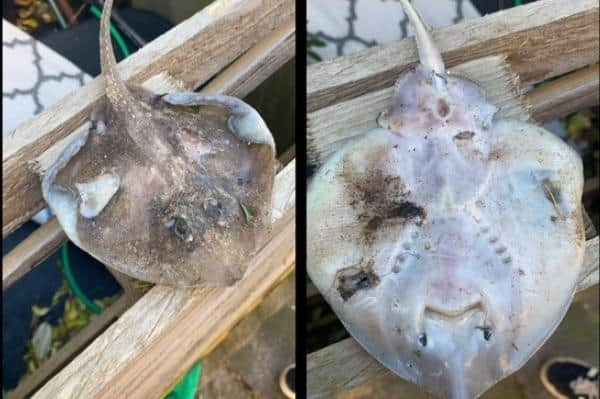Cleveleys mum baffled by discovery of dinner plate-sized ray in back garden
and live on Freeview channel 276
The ray – believed to be a thornback ray commonly found around the British Isles – was discovered by Diane Langridge and her son Logan behind their Anchorsholme Lane West home at around 5pm yesterday.
Diane, 40, said: “My son was cleaning out his fish tanks, and he went into the back garden, and the next thing I heard was him shouting ‘mum, mum!’
Advertisement
Hide AdAdvertisement
Hide Ad"I ran out as quickly as I could, thinking something had happened, and he was stood there holding this ray. It was fresh as well – he was panicking because he thought it was still alive, but we checked and it was definitely dead.


“All that jumped into my head was Steve Irwin, and I shouted ‘put it down before you get stung’! But I did a bit of research and it appears to be a thornback ray.”
Thornbacks are the most commonly encountered ray in the UK and Ireland’s coastal waters. They can grow up to 4ft in width, and can weigh up to 35lbs – though most specimens found around the UK are much smaller.
Diane, a mum of three, said: “It was really bizarre and I just keep thinking it must have been a seagull that has got it, because we’re not far from the beach. Our back garden is off Anchorsholme bowling green and is quite enclosed, so it’s not like someone could have thrown it over.
Advertisement
Hide AdAdvertisement
Hide Ad“But I’ve lived in the Blackpool area for 22 years and I’ve never even seen one on the beach.
"Everybody in the house came running out and wondered what to do with it, and in the end my son buried it because we didn’t want the dogs to get it.
“It is weird though. It’s not something you expect to go into your back garden and see.
"Now I’m wondering, am I going to be out in the garden catching a sun tan and suddenly I’m smacked in the face with a ray? Now I’ve got to watch out for flying fish!”
Advertisement
Hide AdAdvertisement
Hide AdA Lancashire Wildlife Trust spokesman said: “We do like a mystery at the Wildlife Trust! First of all we would look at whether there were any obvious claw marks on the ray, which is, indeed, a thornback ray.
“If a herring gull or crow had picked this up, it would have been too heavy for birds of their size and they would only have carried it for a few metres, out of the reach of their rivals. It would be pretty unusual for a gull to carry its carrion such a long distance.
“We are presuming it was washed ashore dead, so it could have been picked up on the beach by a buzzard or, and this is exciting, by a white-tailed sea eagle, as one has been spotted around Lancashire recently. There is also the possibility that the ray was dumped on a tip by a fishmonger and picked up there, which is not exciting at all.”
